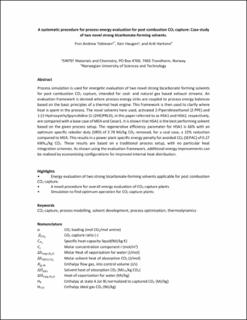| dc.contributor.author | Tobiesen, Finn Andrew | |
| dc.contributor.author | Haugen, Geir | |
| dc.contributor.author | Hartono, Ardi | |
| dc.date.accessioned | 2020-12-28T13:26:32Z | |
| dc.date.available | 2020-12-28T13:26:32Z | |
| dc.date.created | 2018-07-09T13:23:17Z | |
| dc.date.issued | 2018 | |
| dc.identifier.citation | Applied Energy. 2018, 211 161-173. | en_US |
| dc.identifier.issn | 0306-2619 | |
| dc.identifier.uri | https://hdl.handle.net/11250/2721023 | |
| dc.description.abstract | Process simulation is used for energetic evaluation of two novel strong bicarbonate forming solvents for post combustion CO2 capture, intended for coal- and natural gas based exhaust streams. An evaluation framework has been developed where process energy sinks are coupled to process energy balances based on the basic principles of a thermal heat engine. This procedure enables coupling of detailed solvent properties, such as reaction enthalpy, VLE, and kinetics, with the overall process operation, while accounting for the magnitude of the energy sinks in the process. The method identifies areas where there may be room for potential improvement, shows how the fundamental chemical properties of the solvents give rise to the overall capture potential, and highlights interdependencies between major energy sinks in the process. This framework is then used to clarify where heat is spent in the process for two novel solvent systems: activated 2-Piperidineethanol (2-PPE) and 1-(2-Hydroxyethyl)pyrrolidine (1-(2HE)PRLD). These novel solvents are compared with a base case of MEA and Cesar1. Activated 2-Piperidineethanol showed the best performance for the process setup evaluated in this work. The regenerative efficiency parameter for this solvent is 66% with an optimum specific reboiler duty of 2.78 MJ/kg CO2 removed; a 22% reduction compared to MEA in the coal case. Furthermore, the solvent seems to be sufficiently fast to be used in an industrial absorber and is a promising system for post combustion CO2 capture. This results in a power plant specific energy penalty for avoided CO2 of 0.27 kWhel/kg CO2. The evaluation framework can also identify the potential for additional energy improvements by economizing configurations for improved internal heat distribution. | en_US |
| dc.language.iso | eng | en_US |
| dc.publisher | Elsevier | en_US |
| dc.rights | Attribution-NonCommercial-NoDerivatives 4.0 Internasjonal | * |
| dc.rights.uri | http://creativecommons.org/licenses/by-nc-nd/4.0/deed.no | * |
| dc.subject | thermodynamics | en_US |
| dc.subject | process optimization | en_US |
| dc.subject | solvent development | en_US |
| dc.subject | process modelling | en_US |
| dc.subject | CO2 capture | en_US |
| dc.title | A systematic procedure for process energy evaluation for post combustion CO2 capture: Case study of two novel strong bicarbonate-forming solvents | en_US |
| dc.type | Peer reviewed | en_US |
| dc.type | Journal article | en_US |
| dc.description.version | acceptedVersion | en_US |
| dc.rights.holder | © 2018. This is the authors’ accepted and refereed manuscript to the article. This manuscript version is made available under the CC-BY-NC-ND 4.0 license http://creativecommons.org/licenses/by-nc-nd/4.0/ | en_US |
| dc.source.pagenumber | 161-173 | en_US |
| dc.source.volume | 211 | en_US |
| dc.source.journal | Applied Energy | en_US |
| dc.identifier.doi | 10.1016/j.apenergy.2017.10.091 | |
| dc.identifier.cristin | 1596376 | |
| cristin.unitcode | 7401,80,40,0 | |
| cristin.unitname | Prosessteknologi | |
| cristin.ispublished | true | |
| cristin.fulltext | original | |
| cristin.qualitycode | 1 | |

